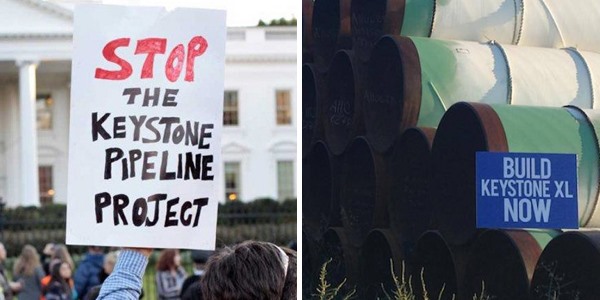
On Friday, the Nebraska Supreme Court affirmed the 2017 decision by the Nebraska Public Service Commission that approved the Keystone XL Pipeline route through the state. While Albertans are hailing the verdict as a great victory, the TC Energy project (formerly TransCanada) is far from being out of the legal woods.

The current battle is over a route alteration ordered in January 2018 that would add five to 10 miles of additional pipe at a cost of $80 million to $160 million. The US Statement Department completed a supplemental environmental review, which project opponents have rejected.
According to Bold Nebraska – a group opposing the 1,897-kilometre, 830,000 barrels per day project that would enable Alberta diluted bitumen to be shipped to the US Gulf Coast – landowners and native tribes will fight the Nebraska Supreme Court’s decision. Opponents will argue that the “new route has undergone no legitimate environmental, property rights or cultural reviews and was approved without any proper notice to landowners and Ponca members along the new route.”
At least three federal legal challenges remain:
- Army Corp. approval: challenge under the National Environmental Policy Act (NEPA) and the Clean Water Act filed July 1 by a coalition of environmental groups. Another lawsuit has been promised over the project’s alleged threats to endangered species, including the whooping crane.
- Challenge to presidential permit for Keystone XL: Seeks a preliminary injunction on construction. Filed in April, oral arguments are scheduled for Oct. 9 in Montana federal court.
- Native American lawsuit: Filed in June by the Rosebud Sioux Tribe and several other parties, also challenged permit issued by President Donald Trump. The Rosebud Sioux refuse to give TC Energy permission to use its roads during construction of the pipeline.
All three cases involve NEPA, which energy law scholar Victor Flatt says is increasingly used by opponents of resource development projects to thwart what they consider attempts by the Trump Administration to circumvent the law with executive orders.
“Those executive orders don’t have the power of law. Those executive orders do not repeal NEPA. They do not change any of the procedural requirements,” the University of Houston professor told Energi Media in an interview. “The orders may have had the opposite impact because in attempting to go more quickly, some of the agencies have failed to follow the required procedures, particularly under NEPA, and they’ve been forced back to the drawing board by Federal Court decisions.”

Flatt’s observation contradicts Premier Jason Kenney’s statement that, “We are also grateful to the US administration for issuing a second permit for KXL, which should remove any legal uncertainty about this pipeline project.” Unfortunately for the new Alberta government, there still appears to be plenty of “legal uncertainty” for Keystone XL.
Jared Margolis is a senior attorney with the Center for Biological Diversity in Vermont. His group is part of the challenge to the Army Corp.’s water crossing approvals, which were done by way of a permit meant to streamline reviews for smaller projects and, therefore, don’t receive the same level of scrutiny required by a pipeline.
“We’re also challenging the lack of analysis under the Endangered Species Act and the big issue there is spills,” he said in an interview. “They haven’t really looked at the impacts of oil spills on them [water crossings], how that would affect the environment.”
He thinks a further lawsuit is likely when the US State Department finishes its review of the route change.

“Once that process was complete, we’re going to take a look,” he said. “We don’t know whether we’re going to challenge that in court or not. But if they continue to do an inadequate analysis as they have in the past, then yeah, we would [file a lawsuit].”
Is it likely that the legal challenges could drag on for years yet?
“There’s been a lot of talk in the press about how they’re close to construction, that all these barriers are dropping, but that’s not true,” he said. “We’re focused on making sure that the analysis is done correctly. If it isn’t, then it could drag out because litigation does take time and this is a very complicated project. So yeah, it’s possible.”
TC Energy CEO Russ Girling had the right approach when he called Friday’s decision “another important step” toward completing Keystone XL. The question for Alberta is, just how many steps – and how many years – might it take until inservice day?
Judging by the lawsuits underway and ready to be filed and those waiting in the wings, Girling and Kenney may want to keep the champagne on ice just a little longer.


Be the first to comment